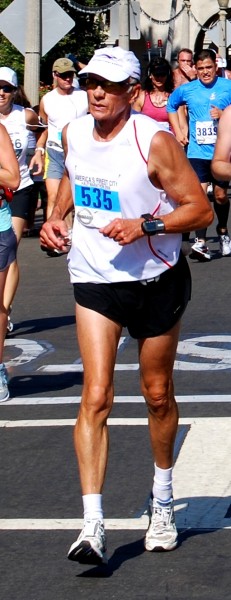 Ha ha ha. I’m laughing because it’s sort of a trick question. The truth is that if you could choose to have only one type of muscle fiber, you would want to choose slow-twitch. But if you already have both slow and fast, and are at a development crossroads, you might want to choose fast-twitch. Let me tell you why.
Ha ha ha. I’m laughing because it’s sort of a trick question. The truth is that if you could choose to have only one type of muscle fiber, you would want to choose slow-twitch. But if you already have both slow and fast, and are at a development crossroads, you might want to choose fast-twitch. Let me tell you why.
What is the twitch?
I used to think that the speed of the twitch indicated how fast you could contract your muscles. I thought that fast-twitch were for doing something speedy but slow-twitch were for lifting heavy loads and taking your time to do it.
I’ve done some research and now it’s as if my mind is a microscope and I have dissected a working muscle. Now I see that muscles have thick filaments called myosin and thin filaments called actin. These little filaments sort of pull on the big one like tiny arms tugging hand over hand on a rope whenever you contract your muscle. If you are pulling a rope toward you, you have to pull hand over hand, alternatively releasing and gripping the rope further along. The action of the little arms in your muscle grabbing, pulling, and letting go is called the twitch.
Slow-Twitch Muscle Fibers
The little hands just move a bit slower. These muscle fibers are great for low velocity endurance activities, like running marathons or swimming across the English channel. They produce energy for this action aerobically, by getting oxygen from your lungs to convert glucose into ATP, which is what cells use for energy.
The reason you wouldn’t want to get rid of all your slow twitch fibers is that your body uses them for normal day-to-day tasks, like picking up a pencil or walking over to the shower.
Fast-Twitch Muscle Fibers
These fibers have little hands that tug fast and strong. They provide great strength intensity for a short period of time. Whenever you lift something really heavy, even if you do it slowly, you are using fast-twitch muscle fibers. Fast-twitch fibers use an anaerobic process to convert chemicals like glucose into ATP. This means that the fast-twitch muscle fibers can work for a short time without oxygen.
While these muscles are being used, they produce byproducts that can later be used with oxygen to assist in recovery. That’s why after you go for a hard sprint you need to breath so heavily.
Fast-twitch muscle also gets bigger the more it is used. Slow-twitch, however, becomes more efficient and smaller, which is why long distance runners look like sticks with eyes.
A Little Controversy
Sometimes people say that low-resistance high-velocity activities don’t build fast-twitch muscle. For those people, I might point them to many boxers (Ali, Frasier, Tyson), who did almost no weight training and still gained large and quick muscle mass. Besides that, I have this quote from an academic publication:
When a movement is to be repeated several times at a high velocity, a great potential of ATP anaerobic re-synthesis (creatine kinase, glycolysis) is required. Lastly, the duration of a high velocity task is determined by the possibility of ATP aerobic re-synthesis and by the body’s energy potential, i.e. by the amount of glycogen reserves in muscles and liver.
Repetition exhausts the body’s oxygen supply which forces the fast-twitch anaerobic muscles to be used.
Why didn’t/don’t boxers do much weight training, you might ask? They think it will make them slower. We have seen, however, that punching a bag a thousand times uses and builds the same fast-twitch muscle fiber that is built by lifting weights. Are the boxers wrong? No, as it turns out, the speed and quickness of your muscles has more to do with the speed and intensity of the neural signals you pass to your muscles. Although doing a slow bench press would work out the same muscles and fast-twitch fibers as punching, it would also train your brain to give those muscles a signal of prolonged intensity, which is not so useful for throwing a fast punch.
What about “Elite-Fitness”?
In “Elite-Fitness”, or exercise regimes like it, you are typically exercising your fast-twitch muscles. You are also training your nervous system to send signals at varying speeds and intensities.
“Elite-Fitness” also trains the chemical systems, or metabolic pathways, in the cells of your muscles to recover faster and to produce ATP faster. By interleaving periods of high intensity with short periods of rest, your aerobic recovery system is also trained, as well as your active areobic recovery, which takes place whenever you breathe during a workout.
Conclusion
Now you know the real difference between fast and slow twitch muscles fibers. You can be sure of yourself when you tell someone what sort of fibers they are using for a workout and rebuke the people who claim your punching or double-undering is just slow-twitch aerobic.
References:
Quickness and velocity in sports movements
YV Verkhoshansky – New Studies in Athletics, 1996
Skeletal Striated Muscle
WikiPedia
How Muscles Work
HowStuffWorks.com

Recent Comments